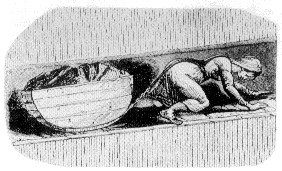Child labour facts for kids
Child labour is when children are forced to work in jobs that are usually done by adults. This means they are involved in economic activities. The International Labour Organization (ILO) says this applies to people up to 15 years old. For dangerous jobs, it applies to those under 17.
Child labour is different from children doing light chores or helping their families. It stops children from going to school. It can also be harmful to their minds, bodies, and feelings. Child labour is against the law in most countries. Today, we often see young boys and girls working in tea stalls, restaurants, hotels, and small shops. Some even work in large factories, like brick factories. The main reason for child labour is poverty.
Contents
What is Child Labour?
Child labour means children are working in ways that:
- Stop them from having a normal childhood.
- Prevent them from going to school regularly.
- Are dangerous or harmful to them mentally, physically, socially, or morally.
Types of Work Children Do
There are two main types of work that young people might do:
- Acceptable Work: This is light or easy work. Children can do it while still being part of their family life. This kind of work can be done in addition to their education.
- Harmful Work: This work is difficult or physically tiring. It might be dangerous, or children may have to work for very long hours. Sometimes, they even have to wear humiliating clothing.
Where Child Labour Happens
Many people in Western countries have strong feelings against child labour. Often, news stories show working children as if they are slaves in a sweatshop in a developing country, making clothes. Or they might show street children in places like South America.
However, the truth is a bit different. Sweatshops exist all over the world, even in countries like the United States or Italy. The fact that children are working is often hidden. More than three-quarters of child labour happens in agriculture or in home-based family activities. Child slaves are actually a small part of the problem. Child labour also existed long before modern factories and global trade. These changes have only made it more visible.
Images for kids
-
A boy repairing a tire in Gambia
-
Young girl working on a loom in Aït Benhaddou, Morocco, in May 2008
-
Agriculture uses 70% of the world's child labour. Above, child worker on a rice farm in Vietnam.
-
Child labour in a quarry, Ecuador
-
Young street vendors in Benin
-
Missouri Governor Joseph W. Folk inspecting child laborers in 1906 in an image drawn by journalist Marguerite Martyn
-
Nepali girls working in brick factory
-
Children engaged in diamond mining in Sierra Leone
-
Working child in Ooty, India
-
Child labour in a coal mine, United States, c. 1912. Photograph by Lewis Hine.
-
Different forms of child labour in Central America, 1999
-
Child labourers, Macon, Georgia, 1909
-
Two girls protesting child labour (by calling it child slavery) in the 1909 New York City Labor Day parade.
-
Arthur Rothstein, Child Labor, Cranberry Bog, 1939. Brooklyn Museum
See also
 In Spanish: Explotación infantil para niños
In Spanish: Explotación infantil para niños






























